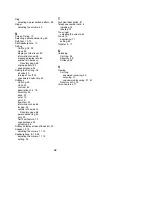
Tones and Their Meanings
VOICE TERMINAL TONES
d
busy signal—A low-pitched tone repeated 60 times a minute
(every second); indicates the number dialed is in use.
d
confirmation tone—Two rising tones; indicates a feature activation
or cancellation has been accepted.
d
dial tone—A continuous tone; indicates dialing can begin.
d
error tone—An alternating high and low tone; indicates a dialing
error, a denial of the service requested, or a failure to dial within a
preset interval (usually 10 seconds) after lifting the handset or dialing
the previous digit.
d
local error tone—A steady low tone; indicates an incorrect button
press.
d
reorder tone—A fast busy signal; indicates a call is blocked.
d
self-test tone—Periodic tones; indicates that the voice terminal is
continuing to perform a self-test.
d
speakerphone reset tones—A rising set of tones; indicates the
speakerphone is adjusting itself to the surrounding room acoustics.
Labeling and Installing the Designation Card
and the Telephone Number Card
Inside the front cover of this user’s manual are button designation cards
on which you can write the telephone number, extension, name, or
feature that each call appearance/feature button can access. These
designation cards match the call appearance/feature buttons on the
voice terminal; that is, the buttons are arranged in four columns. The
first column is labeled a through g; the second column is labeled h
through n; the third column is labeled o through u; the last column is
labeled v through z and A and B.
Below the perforated bottom edge of each designation card is a
telephone number card on which you can write your telephone number.
At the bottom of each designation and telephone number card is an
additional attached section which will make it easier for you to insert
these cards in a typewriter or run the cards through a laser printer.
72














































